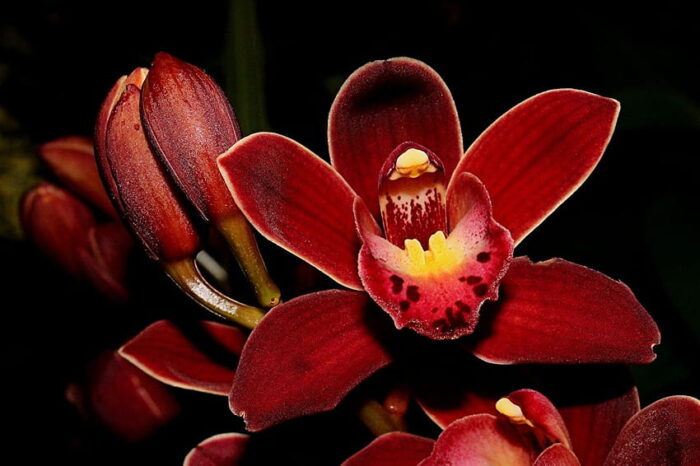Blood orchids, with their mysterious allure and striking appearance, are prized by plant enthusiasts worldwide. Although they may seem intimidating, these unique flowers are easier to care for than you might think. In this comprehensive guide, we’ll explore the fascinating world of blood orchids and share our top tips for helping your exotic beauty flourish.

Meet the Blood Orchid: Haemaria discolor
Blood orchids, known scientifically as Haemaria discolor, are native to the tropical forests of Central and South America. They’re epiphytic, meaning they grow on other plants, such as tree trunks and branches, instead of in soil. The blood orchid gets its name from its vibrant, deep red flowers, which contrast beautifully against the dark, almost black, foliage.
Although blood orchids are not as common as other orchid varieties like Phalaenopsis or Cattleya, their striking appearance makes them well worth seeking out. Ready to take on the challenge of growing a blood orchid in your home? Let’s get started!
Setting the Stage: Preparing Your Home for Your Blood Orchid
Blood orchids need a stable environment that mimics their natural habitat as closely as possible. Before you bring your new plant home, make sure you can provide the following conditions:
- Temperature: Blood orchids prefer daytime temperatures between 65-75°F and nighttime temperatures around 55-60°F.
- Humidity: Aim for 50-70% humidity. You may need to use a humidifier or create a humidity tray to maintain these levels.
- Air circulation: Good air circulation is crucial to prevent fungal infections. Place a fan near your orchid, but don’t point it directly at the plant.
Light It Up: Providing the Perfect Light for Your Blood Orchid
Blood orchids thrive in bright, indirect light. Too little light can cause the leaves to lose their dark coloration, while too much direct sunlight can burn them. To provide the right amount of light, place your blood orchid near an east or west-facing window with a sheer curtain to filter the sunlight. Alternatively, you can use artificial lightings, such as LED or fluorescent grow lights, to supplement natural light or as the primary light source.
The Root of It All: Potting and Potting Mix for Your Blood Orchid
As epiphytes, blood orchids require a well-draining potting mix that allows air to reach their roots. You can purchase a pre-made orchid mix or create your own using a combination of bark, sphagnum moss, perlite, and charcoal.
Choose a pot with plenty of drainage holes to prevent root rot. Blood orchids do well in plastic pots, as these retain moisture longer than clay pots. A clear plastic pot also allows you to monitor your orchid’s root health and water levels.
Water Wisely: Hydrating Your Blood Orchid
Proper watering is essential for your blood orchid’s health. Here are some guidelines to help you strike the right balance:
- Check for moisture: Stick your finger an inch into the potting mix. If it feels dry, it’s time to water.
- Water thoroughly: Place your blood orchid in the sink and allow lukewarm water to flow through the pot until it drains out the bottom. Let the excess water drain completely before returning the plant to its spot.
- Frequency: Water your blood orchid every 5-7 days, depending on factors like temperature, humidity, and the potting mix.
- Use the right water: Tap water can contain minerals harmful to your blood orchid. Instead, use filtered, distilled, or rainwater to ensure your plant receives the cleanest water possible.
Feeding Frenzy: Fertilizing Your Blood Orchid
To support healthy growth and blooming, fertilize your blood orchid with a balanced, water-soluble orchid fertilizer, such as a 20-20-20 formula. Dilute the fertilizer to half or quarter strength and feed your plant every two weeks during the growing season (spring and summer) and once a month during the resting season (fall and winter).
Pruning and Repotting: Ensuring Your Blood Orchid Stays Healthy
Proper pruning and repotting will help your blood orchid thrive. Follow these steps to keep your plant in top condition:
- Pruning: Remove any dead or damaged leaves, roots, or flowers to prevent the spread of disease and encourage new growth. Use sterilized pruning shears or scissors to avoid introducing harmful bacteria or viruses.
- Repotting: Blood orchids should be repotted every 1-2 years, or when the potting mix starts to break down. Choose a pot one size larger than the current one and use fresh orchid mix. Gently remove the old mix from the roots and trim away any dead or damaged roots before placing the plant in its new pot.
Orchid Troubleshooting: Addressing Common Blood Orchid Problems
Despite your best efforts, your blood orchid may encounter some challenges. Here are a few common issues and how to address them:
- Yellow leaves: Overwatering can cause the leaves to turn yellow. Make sure you’re only watering when the potting mix is dry and that the pot has proper drainage.
- Wilting: Underwatering or extreme temperature fluctuations can lead to wilting. Adjust your watering schedule and ensure your orchid is in a stable environment with consistent temperature and humidity levels.
- Pests: Pests like mealybugs, aphids, and spider mites can infest your blood orchid. Remove the pests with a cotton swab dipped in rubbing alcohol, and consider using an insecticidal soap or neem oil if the infestation persists.
Orchid Companions: Choosing Companion Plants for Your Blood Orchid
Surrounding your blood orchid with companion plants can create a microclimate that mimics its natural habitat, improving its overall health and well-being. When selecting companion plants, opt for those with similar light, temperature, and humidity requirements.
Ferns, bromeliads, and other epiphytic plants make excellent choices, as they can thrive in the same conditions as blood orchids. Grouping these plants together helps maintain consistent humidity levels, while also adding visual interest to your indoor garden. When choosing companion plants, be mindful of their growth habits and ensure they don’t overcrowd or compete with your blood orchid for resources.
Troubleshooting Bud Blast: Preventing Blood Orchid Buds from Dropping
Bud blast, or the premature dropping of buds before they have a chance to open, can be a frustrating issue for blood orchid enthusiasts. Several factors can contribute to bud blast, including fluctuations in temperature, humidity, light, and air circulation. To prevent this issue, try to maintain a stable environment for your blood orchid, avoiding sudden changes in temperature or humidity.
Ensure your orchid has access to adequate light and air circulation to promote healthy growth. If you’ve recently moved your orchid to a new location or changed its care routine, this can also cause bud blast. Be patient and give your plant time to adjust to its new conditions; with proper care, it should bloom successfully.
Frequently Asked Questions About Blood Orchids
Can I propagate my blood orchid by dividing it, like other orchid varieties?
Yes, you can propagate blood orchids through division, but it’s best to wait until the plant has multiple pseudobulbs before attempting this method. When repotting, gently separate the pseudobulbs into smaller clusters, ensuring that each division has at least 3-4 healthy pseudobulbs. Plant each division in its own pot with fresh orchid mix, and care for them as you would a mature blood orchid.
How long can I expect my blood orchid to bloom, and how often will it flower?
Blood orchids typically bloom once a year, with the flowering period lasting anywhere from 2-4 weeks. The exact timing of blooms can vary depending on factors such as lighting, temperature, and overall plant health. By providing optimal care and meeting your blood orchid’s specific needs, you can encourage regular blooming and enjoy their stunning red flowers for years to come.
My blood orchid’s leaves are losing their dark color and turning green. What should I do?
If your blood orchid’s leaves are losing their dark color and turning green, it may be a sign that the plant is not receiving enough light. Move your orchid closer to a window with bright, indirect light or consider using artificial lighting to supplement the natural light. Be cautious when adjusting light levels, as too much direct sunlight can burn the leaves. Finding the perfect lighting conditions for your blood orchid may take some trial and error.
Are blood orchids toxic to pets or children?
While blood orchids are not considered toxic to humans or pets, keeping plants out of reach of curious children and animals is always a good idea. Some orchids can cause mild stomach upset if ingested, and certain individuals or animals may have allergic reactions to specific plant species. To ensure the safety of your loved ones and pets, it’s best to keep your blood orchid in a secure location where it can’t be easily accessed.
Conclusion
Cultivating a blood orchid may seem like a daunting task, but with the right care and attention, these exotic beauties can thrive in your home. You can create a suitable habitat that mimics their natural conditions by providing the proper environment, light, potting mix, watering, and fertilizing. Additionally, your blood orchid will maintain its health and vitality with regular pruning, repotting, and pest control. As you embrace the challenge of growing a blood orchid, you’ll develop your gardening skills and enjoy the stunning visual impact of these vibrant red flowers, transforming your living space into a tropical oasis.

About Author
Hannah Anderson is a passionate garden enthusiast with over a decade of experience. She has been sharing her knowledge and expertise on this website and her articles and tips have helped countless individuals create beautiful and thriving gardens. Whether you’re a seasoned green thumb or just starting out, Hannah’s practical advice and creative ideas will inspire and guide you on your gardening journey.
